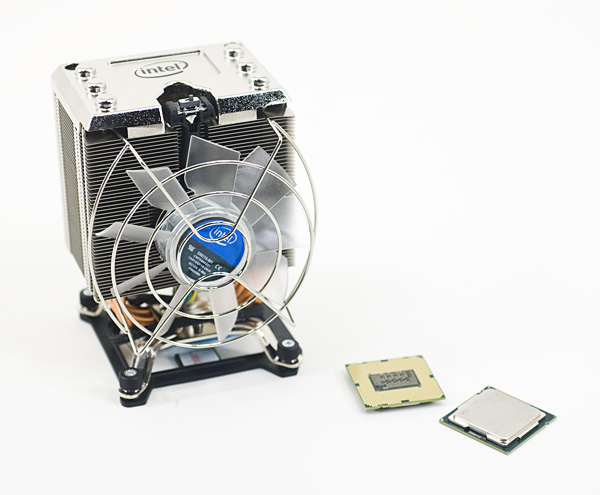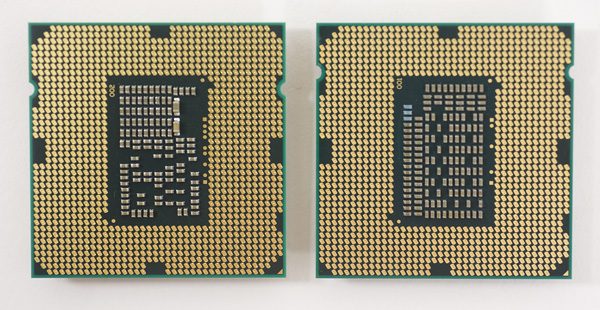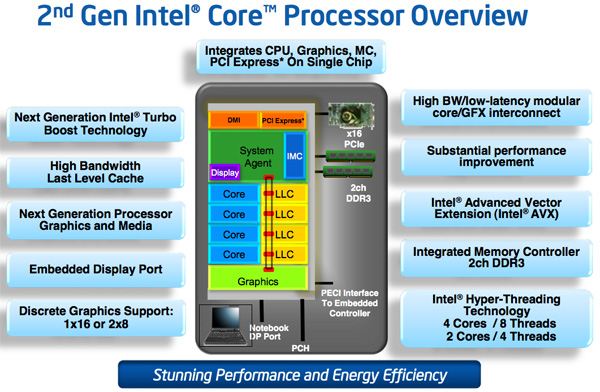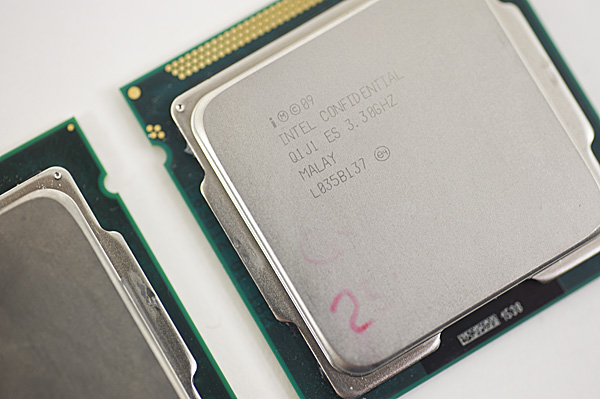The Sandy Bridge Review: Intel Core i7-2600K, i5-2500K and Core i3-2100 Tested
by Anand Lal Shimpi on January 3, 2011 12:01 AM ESTIntel never quite reached 4GHz with the Pentium 4. Despite being on a dedicated quest for gigahertz the company stopped short and the best we ever got was 3.8GHz. Within a year the clock (no pun intended) was reset and we were all running Core 2 Duos at under 3GHz. With each subsequent generation Intel inched those clock speeds higher, but preferred to gain performance through efficiency rather than frequency.
Today, Intel quietly finishes what it started nearly a decade ago. When running a single threaded application, the Core i7-2600K will power gate three of its four cores and turbo the fourth core as high as 3.8GHz. Even with two cores active, the 32nm chip can run them both up to 3.7GHz. The only thing keeping us from 4GHz is a lack of competition to be honest. Relying on single-click motherboard auto-overclocking alone, the 2600K is easily at 4.4GHz. For those of you who want more, 4.6-4.8GHz is within reason. All on air, without any exotic cooling.
Unlike Lynnfield, Sandy Bridge isn’t just about turbo (although Sandy Bridge’s turbo modes are quite awesome). Architecturally it’s the biggest change we’ve seen since Conroe, although looking at a high level block diagram you wouldn’t be able to tell. Architecture width hasn’t changed, but internally SNB features a complete redesign of the Out of Order execution engine, a more efficient front end (courtesy of the decoded µop cache) and a very high bandwidth ring bus. The L3 cache is also lower and the memory controller is much faster. I’ve gone through the architectural improvements in detail here. The end result is better performance all around. For the same money as you would’ve spent last year, you can expect anywhere from 10-50% more performance in existing applications and games from Sandy Bridge.
I mentioned Lynnfield because the performance mainstream quad-core segment hasn’t seen an update from Intel since its introduction in 2009. Sandy Bridge is here to fix that. The architecture will be available, at least initially, in both dual and quad-core flavors for mobile and desktop (our full look at mobile Sandy Bridge is here). By the end of the year we’ll have a six core version as well for the high-end desktop market, not to mention countless Xeon branded SKUs for servers.
The quad-core desktop Sandy Bridge die clocks in at 995 million transistors. We’ll have to wait for Ivy Bridge to break a billion in the mainstream. Encompassed within that transistor count are 114 million transistors dedicated to what Intel now calls Processor Graphics. Internally it’s referred to as the Gen 6.0 Processor Graphics Controller or GT for short. This is a DX10 graphics core that shares little in common with its predecessor. Like the SNB CPU architecture, the GT core architecture has been revamped and optimized to increase IPC. As we mentioned in our Sandy Bridge Preview article, Intel’s new integrated graphics is enough to make $40-$50 discrete GPUs redundant. For the first time since the i740, Intel is taking 3D graphics performance seriously.
| CPU Specification Comparison | ||||||||
| CPU | Manufacturing Process | Cores | Transistor Count | Die Size | ||||
| AMD Thuban 6C | 45nm | 6 | 904M | 346mm2 | ||||
| AMD Deneb 4C | 45nm | 4 | 758M | 258mm2 | ||||
| Intel Gulftown 6C | 32nm | 6 | 1.17B | 240mm2 | ||||
| Intel Nehalem/Bloomfield 4C | 45nm | 4 | 731M | 263mm2 | ||||
| Intel Sandy Bridge 4C | 32nm | 4 | 995M | 216mm2 | ||||
| Intel Lynnfield 4C | 45nm | 4 | 774M | 296mm2 | ||||
| Intel Clarkdale 2C | 32nm | 2 | 384M | 81mm2 | ||||
| Intel Sandy Bridge 2C (GT1) | 32nm | 2 | 504M | 131mm2 | ||||
| Intel Sandy Bridge 2C (GT2) | 32nm | 2 | 624M | 149mm2 | ||||
It’s not all about hardware either. Game testing and driver validation actually has real money behind it at Intel. We’ll see how this progresses over time, but graphics at Intel today very different than it has ever been.
Despite the heavy spending on an on-die GPU, the focus of Sandy Bridge is still improving CPU performance: each core requires 55 million transistors. A complete quad-core Sandy Bridge die measures 216mm2, only 2mm2 larger than the old Core 2 Quad 9000 series (but much, much faster).
As a concession to advancements in GPU computing rather than build SNB’s GPU into a general purpose compute monster Intel outfitted the chip with a small amount of fixed function hardware to enable hardware video transcoding. The marketing folks at Intel call this Quick Sync technology. And for the first time I’ll say that the marketing name doesn’t do the technology justice: Quick Sync puts all previous attempts at GPU accelerated video transcoding to shame. It’s that fast.
There’s also the overclocking controversy. Sandy Bridge is all about integration and thus the clock generator has been moved off of the motherboard and on to the chipset, where its frequency is almost completely locked. BCLK overclocking is dead. Thankfully for some of the chips we care about, Intel will offer fully unlocked versions for the enthusiast community. And these are likely the ones you’ll want to buy. Here’s a preview of what’s to come:
The lower end chips are fully locked. We had difficulty recommending most of the Clarkdale lineup and I wouldn’t be surprised if we have that same problem going forward at the very low-end of the SNB family. AMD will be free to compete for marketshare down there just as it is today.
With the CPU comes a new platform as well. In order to maintain its healthy profit margins Intel breaks backwards compatibility (and thus avoids validation) with existing LGA-1156 motherboards, Sandy Bridge requires a new LGA-1155 motherboard equipped with a 6-series chipset. You can re-use your old heatsinks however.

Clarkdale (left) vs. Sandy Bridge (right)
The new chipset brings 6Gbps SATA support (2 ports) but still no native USB 3.0. That’ll be a 2012 thing it seems.













283 Comments
View All Comments
CreativeStandard - Monday, January 3, 2011 - link
PC mag reports these new i7's only support up to 1333 DDR3 but you are running faster, is PC mag wrong, what is the maximum supported memory speeds?Akv - Monday, January 3, 2011 - link
Is it true that it has embedded DRM ?DanNeely - Monday, January 3, 2011 - link
Only to the extent that like all intel Core2 and later systems it supports a TPM module to allow locking down servers in the enterprise market and that the system *could* be used to implement consumer DRM at some hypothetical point in the future; but since consumer systems aren't sold with TPM modules it would have no impact on systems bought without.shabby - Monday, January 3, 2011 - link
Drm is only on the h67 chipset, and its basically just for watching movies on demand and nothing more.Akv - Monday, January 3, 2011 - link
Mmmhh... ok...Nevertheless the intel HD + H67 was already modest, if it has DRM in addition then it becomes not particularly seducing.
marraco - Monday, January 3, 2011 - link
Thanks for adding Visual Studio compilation benchmark. (Although you omitted the 920).It seems that not even SSD, nor can better processors do much for that annoying time waster. It does not matter how much money you throw at it.
I wish to see also SLI/3-way SLI/crossfire performance, since the better cards frequently are CPU bottlenecked. How much better it does relative to i7 920? And with good cooler at 5Ghz?
Note: you mention 3 video cards on test setup, but what one is on the benchmarks?
Anand Lal Shimpi - Monday, January 3, 2011 - link
You're welcome on the VS compile benchmark. I'm going to keep playing with the test to see if I can use it in our SSD reviews going forward :)I want to do more GPU investigations but they'll have to wait until after CES.
I've also updated the gaming performance page indicating what GPU was used in each game, as well as the settings for each game. Sorry, I just ran out of time last night and had to catch a flight early this morning for CES.
Take care,
Anand
c0d1f1ed - Monday, January 3, 2011 - link
I wonder how this CPU scores with SwiftShader. The CPU part actually has more computing power than the GPU part. All that's lacking to really make it efficient at graphics is support for gather/scatter instructions. We could then have CPUs with more generic cores instead.aapocketz - Monday, January 3, 2011 - link
I have read that CPU overclock is only available on P67 motherboards, and H67 motherboards cannot overclock the CPU, so you can either use the onboard graphics OR get overclocking? Is this true?"K-series SKUs get Intel’s HD Graphics 3000, while the non-K series SKUs are left with the lower HD Graphics 2000 GPU."
whats the point of improving the graphics on K series, if pretty much everyone who gets one will have a P67 motherboard which cannot even access the GPU?
Let me know if I am totally not reading this right...
MrCromulent - Monday, January 3, 2011 - link
Great review as always, but on the HTPC page I would have wished for a comparison of the deinterlacing quality of SD (480i/576i) and HD (1080i) material. Ati's onboard chips don't offer vector adaptive deinterlacing for 1080i material - can Intel do better?My HD5770 does a pretty fine job, but I want to lose the dedicated video card in my next HTPC.